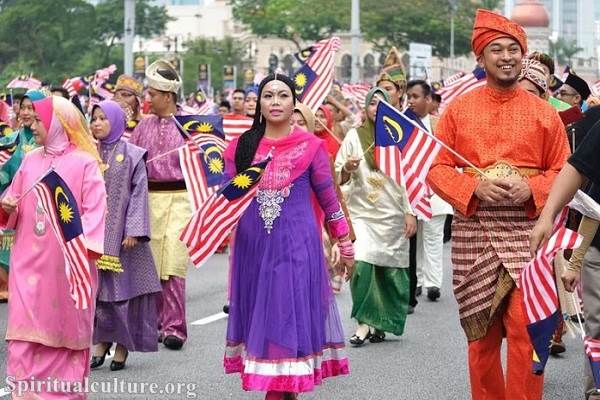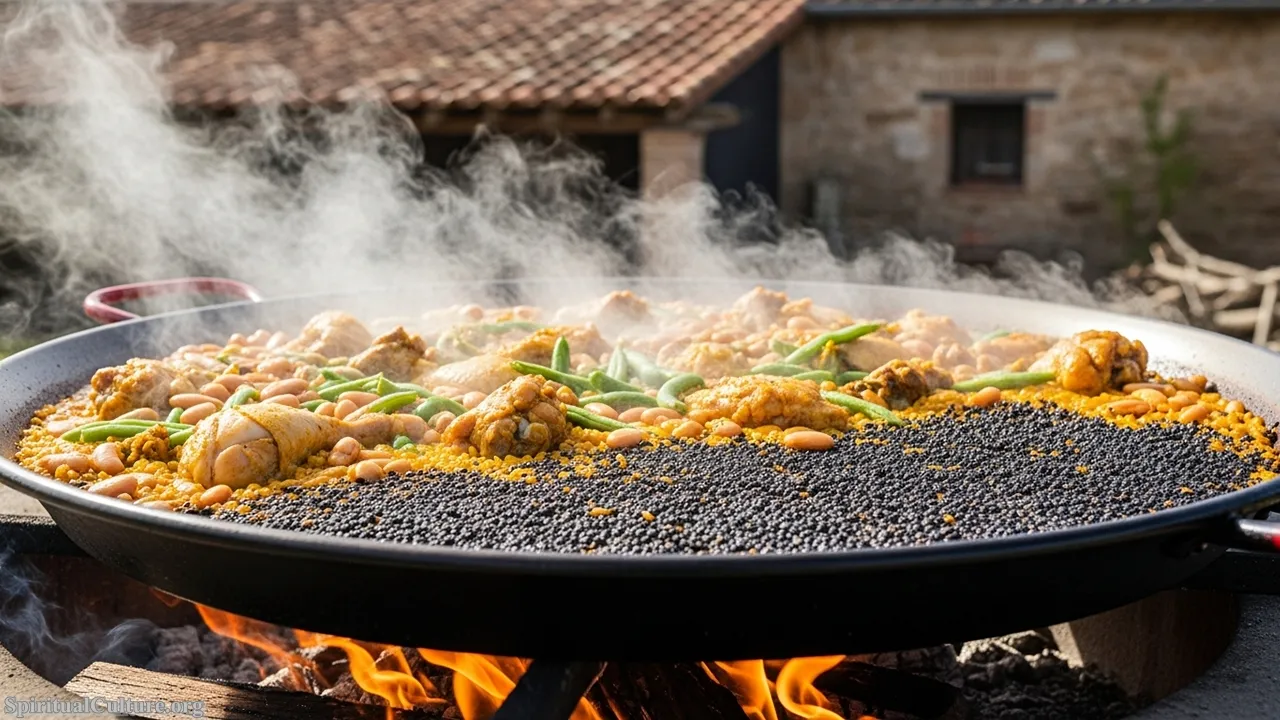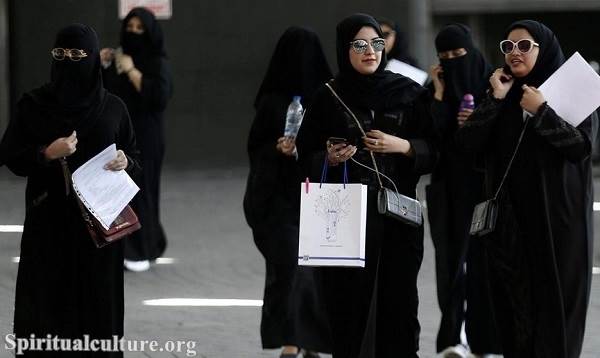The cultural landscape of Korea, often referred to as the Land of the Morning Calm, has transformed in the 21st century to become a significant global powerhouse. While the world may currently celebrate K-Pop and K-Dramas, the enduring strength of the nation rests upon a foundation of ancient traditions deeply rooted in Confucianism, Buddhism, and indigenous Shamanism. These traditions—ranging from communal food preparation to the revered practice of ancestral rites—have not only provided stability throughout centuries of upheaval but have now been embraced as expressions of national identity on a world stage. The designation of numerous cultural practices on the UNESCO Intangible Cultural Heritage list, as updated to the Current Time of Writing, affirms their universal value and the commitment to their preservation.
At Spiritual Culture, we look beyond mere popularity to assess the true influence of these traditions through the lens of their spiritual meaning, historical continuity, and their capacity to foster collective social harmony. This ranking is built upon a deep analytical perspective, prioritizing practices that reinforce the core humanistic values of filial piety, communal bonding, and respect for nature and the cyclical passage of time. The power of Korean culture lies not just in its artistic expression, but in the unwavering principles of respect and community it instills in its practitioners worldwide.
The following guide details the most influential traditions, demonstrating how ancient customs remain profoundly relevant to modern life. Each entry is a testament to the resilience and spiritual depth of the Korean people, offering powerful lessons in heritage and humanity for the global community.
Table of the Top 10 Most Influential Korean Cultural Traditions (2025)
| Rank | Tradition | Core Cultural Significance | Spiritual/Philosophical Basis | Global Recognition (As of Nov 2025) |
|---|---|---|---|---|
| 1 | Jesa & Ancestral Rites (Charye, Seongmyo) | Filial Piety, Family Continuity, Social Order | Confucianism (Hyodo/Filial Piety) & Indigenous Beliefs | Core element of Seollal & Chuseok (Major National Holidays) |
| 2 | Hangeul (The Korean Alphabet) | National Identity, Education, Literacy/Accessibility | Philosophical & Humanistic (King Sejong’s vision for the common people) | UNESCO Memory of the World Register (1997) |
| 3 | Kimjang (Making and Sharing Kimchi) | Communal Solidarity, Collective Identity, Seasonal Harmony | Yin-Yang Harmony in food, Community Spirit (Dure) | UNESCO Intangible Cultural Heritage (2013) |
| 4 | Seollal & Chuseok (Lunar New Year & Harvest Festival) | Cyclical Time, Family Reunion, Gratitude for Harvest | Shamanistic Harvest Rites, Confucian Ancestor Worship | National ‘Great Migration’ Holidays, Core Cultural Calendar Events |
| 5 | Hanbok (Traditional Korean Attire) | Aesthetic Philosophy (Line, Color), Social Status Marker | Obangsaek (Five Cardinal Colors), Simplicity/Elegance | International Fashion Influence, Symbol of Cultural Heritage |
| 6 | Taekkyeon (Traditional Martial Art) | Mind-Body Harmony, Fluidity, Non-Aggression | Principles of the Flowing Water (Gim-Se), Non-violent defense | UNESCO Intangible Cultural Heritage (2011) |
| 7 | Talchum (Mask Dance Drama) | Social Commentary, Satire, Ritual Cleansing | Shamanistic Rituals (exorcism), Community Catharsis | UNESCO Intangible Cultural Heritage (2022) |
| 8 | Darye (Korean Tea Ceremony) | Mindfulness, Tranquility, Respect (Hospitality) | Buddhism (Zen) and Confucian Etiquette | Global promotion of Korean Aesthetics and Etiquette (Dado) |
| 9 | Jang Making (Soy Sauce, Doenjang, Gochujang) | Culinary Foundation, Preservation, Family Knowledge | Purity, Time-Honored Fermentation, Knowledge Transmission | UNESCO Intangible Cultural Heritage (2024 – Knowledge, beliefs and practices related to jang making) |
| 10 | Jongmyo Jerye & Jeryeak (Royal Ancestral Rite) | State Piety, Lineage, Political Legitimacy | Confucian State Rituals (Highest form of Rites) | UNESCO Intangible Cultural Heritage (2008) & World Heritage Site (Jongmyo Shrine) |
#10. Jongmyo Jerye & Jeryeak (Royal Ancestral Rite and Music)
The Jongmyo Jerye is the ancient and highly formalized ritual ceremony dedicated to the deceased kings and queens of the Joseon Dynasty, performed annually at the Jongmyo Shrine in Seoul. Recognized as a UNESCO Intangible Cultural Heritage (2008), this rite stands as the highest expression of Confucian state ritual, maintaining a perfect continuity of music, dance, and customs that date back centuries. Though no longer a ruling dynasty, its meticulous preservation provides a direct, living link to the nation’s 500-year-long philosophical and political history, making it a powerful symbol of deep historical respect that transcends modern governance.
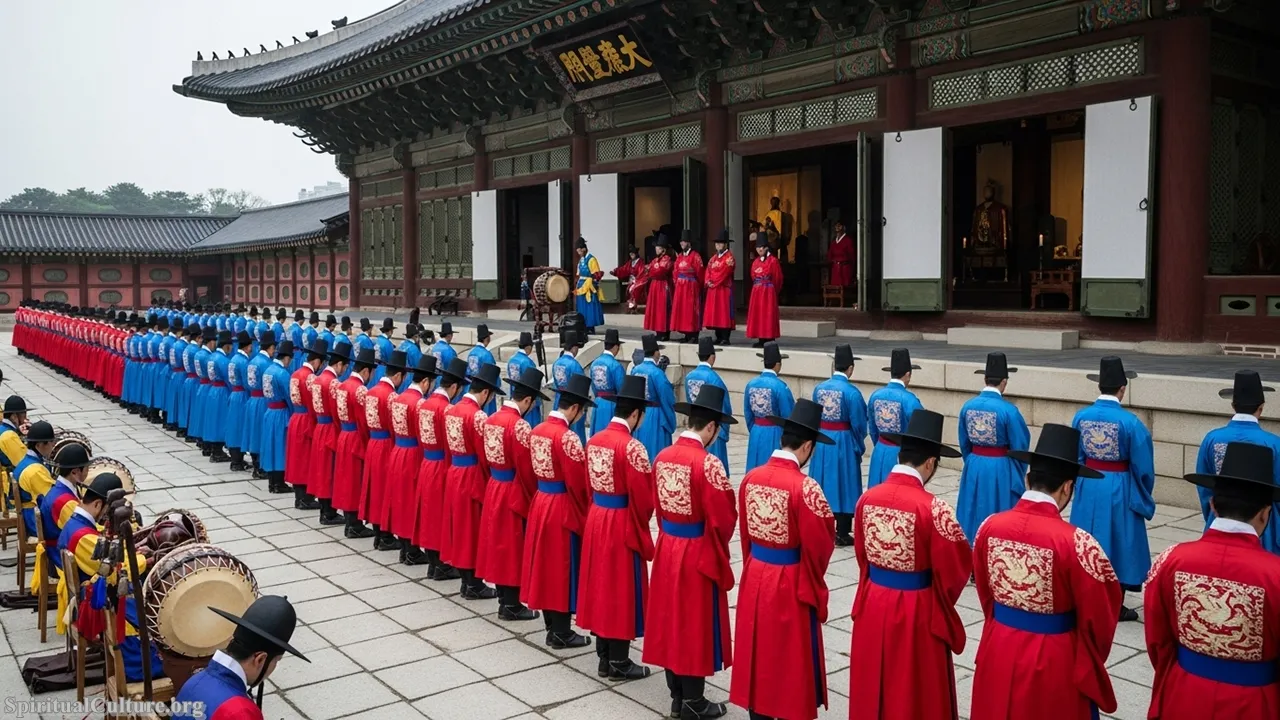
The spiritual impact of the Jerye is one of cosmic and social order. The accompanying ritual music, Jeryeak, and the court dances, Botaepyeong and Jeongdaeeop, are performed with solemn precision to ensure harmony between the spirits of the ancestors, the ruling government, and the common people. This act of collective memory reinforces the spiritual idea that the nation’s well-being is contingent upon the respectful acknowledgment of its past leaders. For Spiritual Culture, this tradition is paramount as a display of preservation value, showing that cultural heritage is a responsibility shared by the entire community.
Observing the Jongmyo Jerye offers a profound reflection on the concept of time and legacy. It teaches that the spiritual well-being of a society is inextricably tied to its reverence for the lineage that paved the way. Its preservation, maintained with government and civilian support, highlights the moral lesson that true civilization is measured by how deeply it honors its foundations, demonstrating a national commitment to heritage far beyond monetary value.
Cultural/Spiritual Highlights
- UNESCO Double Inscription: The shrine is a World Heritage Site (1995), and the ritual/music (Jerye/Jeryeak) is Intangible Cultural Heritage (2008).
- Highest Confucian Piety: Represents the pinnacle of Confucian ancestral rites, performed by descendants of the royal family.
- Jeryeak: The accompanying ritual music is a surviving example of 15th-century court music, played with ancient instruments.
#9. Jang Making (Traditional Fermented Sauces)
Jang Making—the traditional, time-honored process of fermenting core condiments like Gochujang (chili paste), Doenjang (soybean paste), and Ganjang (soy sauce)—was recently inscribed on the UNESCO Intangible Cultural Heritage list in 2024. These sauces are not merely food items; they are the foundation of Korean cuisine, known as the “mother’s hand taste” (Son-mat). The process, passed down across generations, requires specific conditions, a deep understanding of natural cycles, and the spiritual virtue of patience, often taking years to complete.
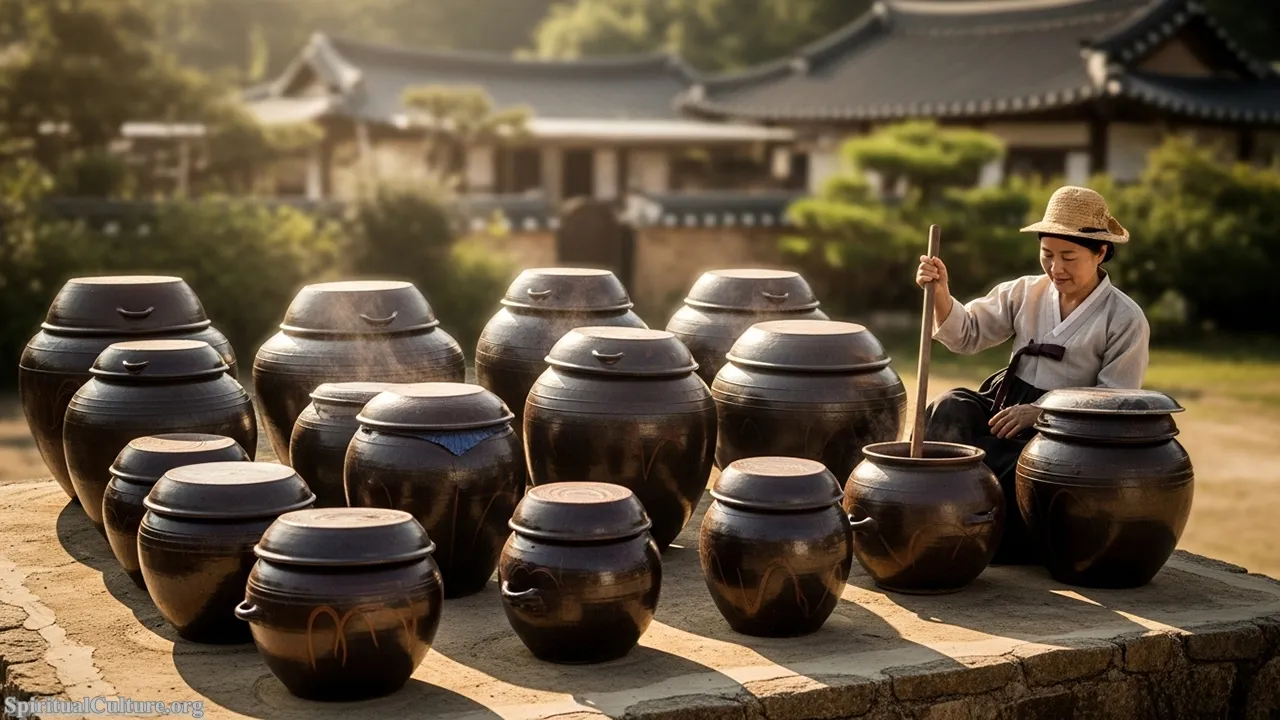
The spiritual impact of Jang is rooted in the concepts of purity and patience. The fermentation process is deeply linked to the solar calendar and the natural environment, where the traditional pots (onggi) are exposed to the sun and air, signifying a cooperative effort between humanity and nature. This tradition is a daily, edible expression of Korean identity, ensuring food security and communal health through beneficial fermentation. The knowledge is sacred, often linked to the reputation of the household or community, embodying a trust in natural transformation.
The preservation of Jang Making, even amidst modern, mass-produced alternatives, reflects the moral lesson that the deepest cultural value often resides in the things that sustain us daily. It is a powerful reminder that the best things in life require time, attention, and an unshakeable connection to the earth’s rhythm. At Spiritual Culture, we see this as a celebration of the enduring wisdom of ancestral foodways.
Cultural/Spiritual Highlights
- UNESCO Status: Inscribed in 2024 as “Knowledge, beliefs and practices related to jang making.”
- Onggi: The traditional earthenware pots used are breathable, facilitating the unique fermentation process.
- Food Spirituality: Jang is traditionally made in a spiritual location within the house, often involving purifying rituals to ensure good fermentation.
#8. Darye (The Korean Tea Ceremony)
The Darye, or Korean Tea Ceremony, is a ritualistic practice centered on the mindful preparation and serving of tea, primarily green tea (nokcha). While its ritualistic form was historically refined by Buddhist monks for contemplative purposes, it was embraced by the Confucian nobility as an exercise in etiquette and hospitality. Today, Darye is practiced as a cultural and spiritual discipline, promoting tranquility and respect, often using simple, natural Korean ceramics that emphasize the beauty of unadorned simplicity.
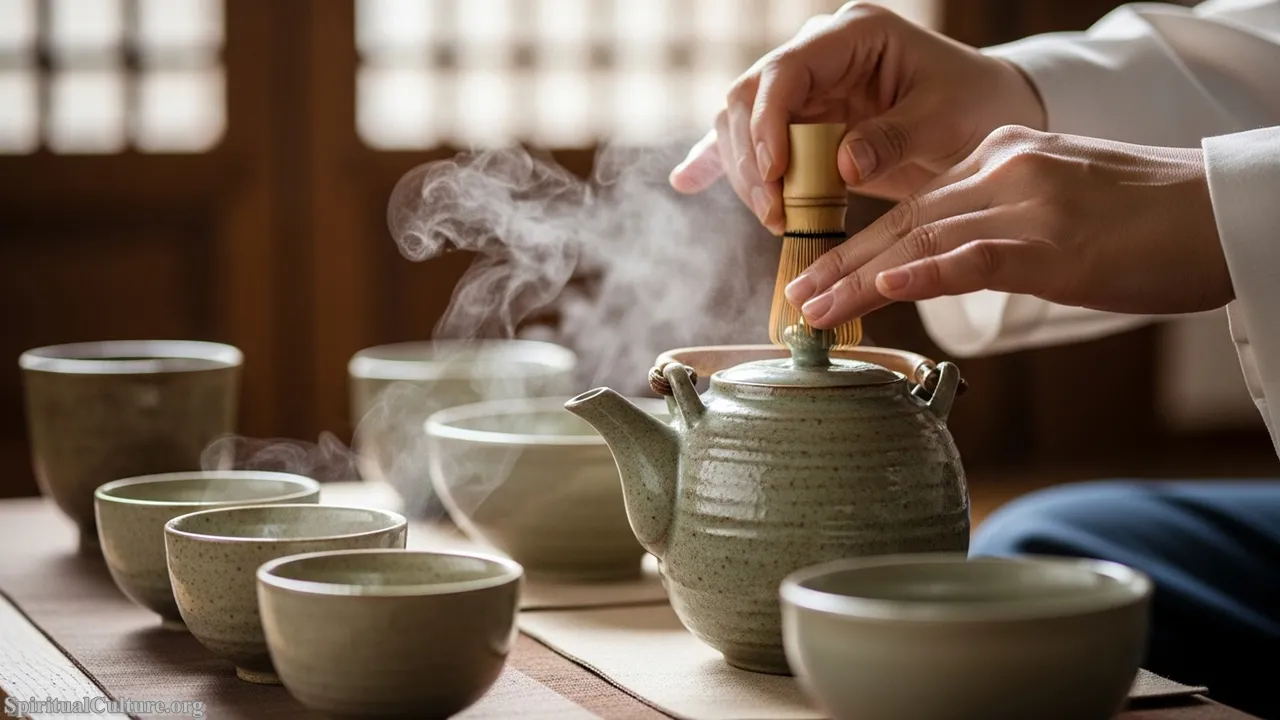
The spiritual impact is one of tranquility and respectful engagement. The ceremony is less about rigid rules and more about the cultivation of a calm heart (Jeongjungdong – stillness within movement). The slow, deliberate movements and the focus on the moment of serving and receiving the tea create a profound space for mindfulness, drawing heavily on Zen Buddhist principles. It is a quiet social art that spiritually prepares the mind for deeper connection, forcing participants to slow down and truly acknowledge one another and the simple elegance of nature’s offerings.
The preservation value of Darye lies in its role as an antidote to the modern world’s speed, offering a moment of intentional pause. It teaches the moral lesson that true elegance is found in simplicity and courtesy. By focusing on the smallest act—the pouring of tea—it illuminates the importance of intention in all aspects of life, a value Spiritual Culture encourages for personal well-being.
Cultural/Spiritual Highlights
- Buddhist Roots: Historically used as a contemplative practice (meditation in action) by monks.
- Core Value: Emphasis on simplicity and naturalism (yungyeol) over extravagance.
- Darye Etiquette: The entire ceremony is an act of formalized respect and hospitality, reflecting Confucian ideals of social harmony.
#7. Talchum (Mask Dance Drama)
Talchum, the Korean mask dance drama, is a vibrant and powerful tradition that combines dance, music, dramatic dialogue, and sharp social satire. Often performed during important festivals, it addresses a range of societal issues, including corrupt officials, the hypocrisy of the ruling class, and the challenges faced by the common people. This tradition was inscribed on the UNESCO Intangible Cultural Heritage list in 2022, recognizing its continuous role as a communal voice and an outlet for public commentary.

The spiritual impact of Talchum is deeply tied to the concept of catharsis and communal cleansing. The masks themselves often represent spiritual entities or archetypes—from grotesque nobles to protective spirits—allowing the performers to momentarily shed their personal identities and embody social critique. It functions as a ritualistic safety valve for the community, where suppressed grievances can be openly aired and exorcised through humor and satire, leading to a spiritual renewal and social equilibrium after the performance.
Talchum offers the profound moral lesson that the spiritual health of a society requires the freedom to critique and laugh at its own failings. Its continued popularity demonstrates the preservation value of a tradition that balances solemn ritual with irreverent humor. For Spiritual Culture, this tradition showcases the spiritual resilience found in collective expression and the powerful, cleansing force of truth spoken through art.
Cultural/Spiritual Highlights
- UNESCO Inscription: Recognized in 2022 for its social and cultural significance.
- Ritualistic Purpose: Historically incorporated exorcism rituals (gut) to drive away evil spirits and bring prosperity.
- Social Satire: The primary function is to satirize the privileged class, offering a voice to the marginalized.
#6. Taekkyeon (Traditional Korean Martial Art)
Taekkyeon is one of Korea’s oldest martial arts, distinguished by its fluid, graceful, and almost dance-like movements that emphasize footwork and sweeps rather than abrupt, linear strikes. Unlike more aggressively styled martial arts, Taekkyeon is characterized by its principle of non-aggression and a focus on yielding and circling, making it a meditative art form as much as a fighting discipline. Its inscription on the UNESCO Intangible Cultural Heritage list in 2011 attests to its unique philosophical and physical value.
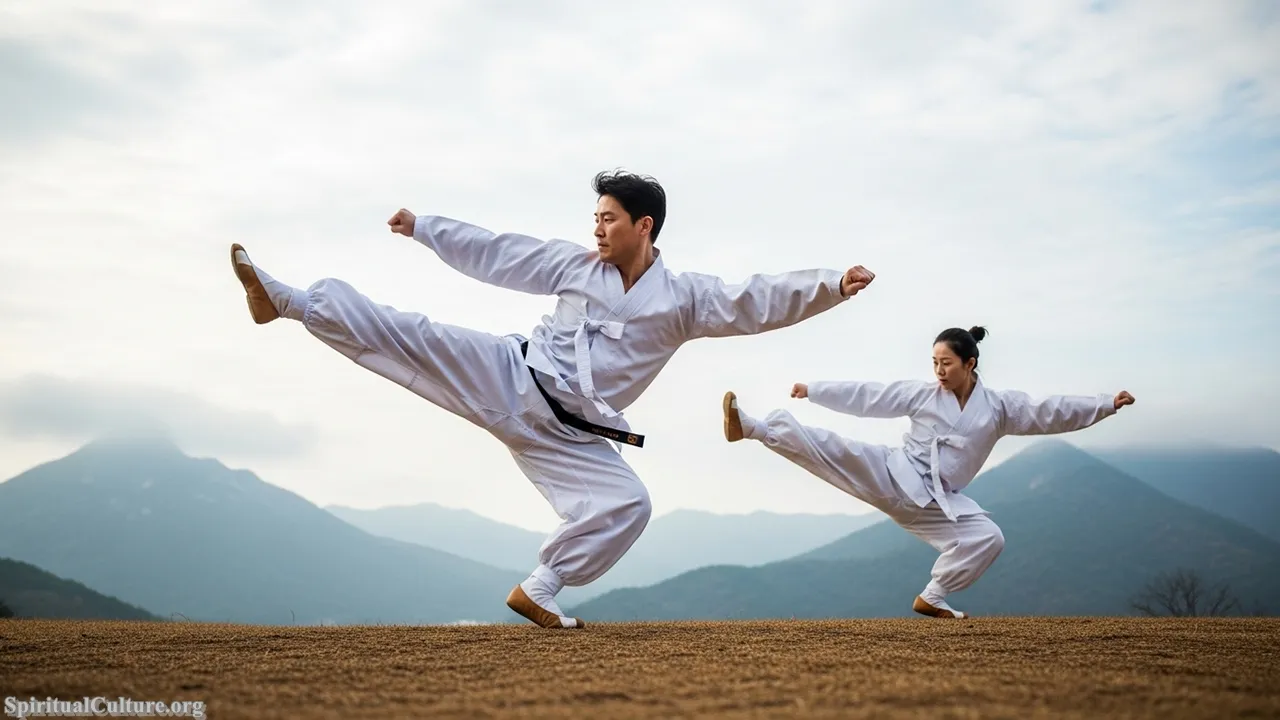
The spiritual impact of Taekkyeon lies in the pursuit of mind-body harmony (Gim-Se). The movements mimic the flow of nature, such as wind and water, teaching the practitioner that strength is not about brute force but about flexibility, timing, and using the opponent’s force against them. It cultivates an inner tranquility and a deep connection to the body’s natural state, making the martial art a spiritual path toward self-control and respect for an adversary. This philosophical approach makes it a powerful and enduring cultural export.
The preservation of Taekkyeon teaches the moral lesson that the greatest strength is often expressed through gentle, yielding movement and non-violence. It encourages practitioners to embody a philosophy of adaptability and inner peace. Spiritual Culture recognizes this tradition as a living testament to the Asian spiritual principle that ultimate power resides in harmonizing with the natural world.
Cultural/Spiritual Highlights
- UNESCO Inscription: Recognized in 2011, it is the first martial art to be inscribed on the UNESCO list.
- Non-Aggressive Principle: Techniques focus on defense, sweeps, and throws rather than direct strikes, embodying a spiritual aversion to unnecessary conflict.
- Ritualized Play: Historically practiced as a sport/game (Gyeollyeong) to promote community bonding and physical health.
#5. Hanbok (Traditional Korean Attire)
The Hanbok is the iconic traditional Korean garment, known for its vibrant colors, elegant lines, and the distinctive absence of pockets, emphasizing its aesthetic over practicality. While it was once the daily wear for all Koreans, it is now reserved for major holidays, weddings, and ceremonial occasions, solidifying its status as a potent cultural symbol. The garment’s current global influence, driven by modern K-Culture, has seen it re-emerge in contemporary fashion, but its spiritual significance remains in its design principles.
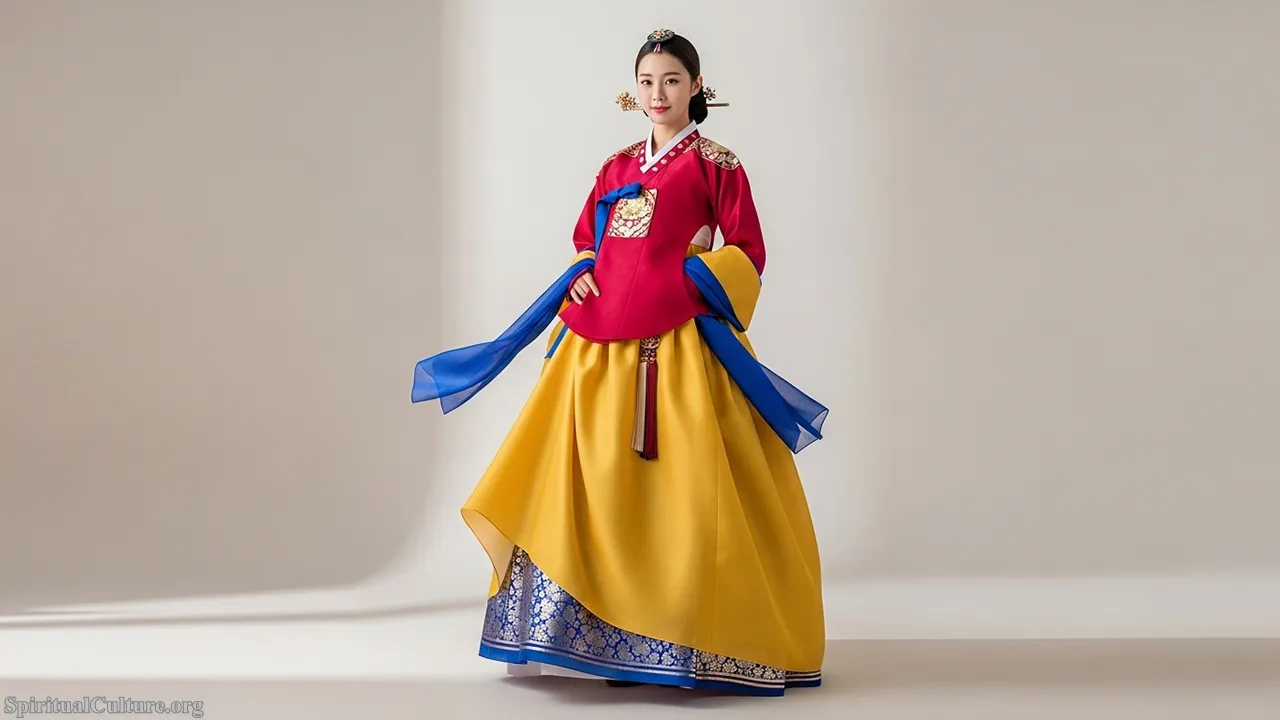
The spiritual impact of the Hanbok is found in its adherence to the philosophy of Obangsaek (Five Cardinal Colors) and the harmony of nature. The colors traditionally chosen represented the five elements and directions, linking the wearer to the cosmic order and protecting them from ill fortune. The loose, flowing lines symbolize the virtues of grace and humility, encouraging a dignified comportment that reflects a spiritual inner calm. Wearing a Hanbok is not just dressing up; it is an act of honoring one’s heritage and symbolically aligning with ancient Korean spiritual aesthetics.
The Hanbok’s revitalization, particularly among the younger generation, demonstrates the powerful moral lesson that cultural heritage can be both traditional and fashionable. It provides a tangible link to ancestral memory and a celebration of a distinct national identity. For Spiritual Culture, the Hanbok represents a preserved aesthetic philosophy, showing how principles of spiritual elegance can be physically worn and celebrated.
Cultural/Spiritual Highlights
- Obangsaek: The five cardinal colors (blue, white, red, black, yellow) represent the five elements and are spiritually protective.
- Simplicity & Lines: The form is designed to hide the body’s curves, emphasizing a spiritual humility and grace.
- Ceremonial Use: It is mandatory for bowing (Sebae) during Seollal, reinforcing respect for elders and ancestors.
#4. Seollal & Chuseok (Lunar New Year and Harvest Festival)
Seollal (Lunar New Year) and Chuseok (Harvest Festival, often called Korean Thanksgiving) are the twin pillars of the Korean cultural calendar, dictating what is famously known as the “Great Migration” as millions of people return to their ancestral homes. Both holidays are centered on the family reunion, the respectful offering of thanks to ancestors (Jesa), and the sharing of special symbolic foods like Tteokguk (rice cake soup) for Seollal and Songpyeon (half-moon rice cakes) for Chuseok.

The spiritual impact is one of gratitude, continuity, and the cyclical nature of life. Seollal marks a spiritual clean slate, where eating Tteokguk symbolizes gaining one more year of age and wisdom. Chuseok is an ancient harvest rite, thanking the ancestral spirits for a bountiful yield. These traditions directly embody the Confucian value of Hyodo (filial piety) by reinforcing familial bonds and the crucial spiritual connection between the living and the departed. They are moments of collective consciousness and spiritual alignment with both the family lineage and the seasonal calendar.
These two holidays offer the powerful moral lesson that no matter the pace of modern life, the importance of family and gratitude for life’s blessings must remain paramount. The willingness of the entire nation to participate in this mass pilgrimage is a profound, non-verbal commitment to their heritage. Spiritual Culture holds these holidays as the most vital engine for preserving Korea’s humanistic and collective spiritual fabric.
Cultural/Spiritual Highlights
- Great Migration: A national demonstration of filial piety, with massive movement back to ancestral homes.
- Sebae: The ritual bow to elders during Seollal, signifying respect and the receiving of blessings.
- Ancestral Veneration: Both holidays feature Charye (ancestral rites) and Seongmyo (grave visiting), reaffirming the spiritual presence of ancestors.
#3. Kimjang (The Communal Making and Sharing of Kimchi)
Kimjang, the tradition of making and sharing large quantities of kimchi in late autumn to sustain the community through winter, is a practice that transcends mere cooking. Inscribed on the UNESCO Intangible Cultural Heritage list in 2013, it is recognized as a profound example of communal cooperation (Dure) and a sophisticated cultural knowledge of food preservation. This collective act ensures that every family, regardless of economic status, is supplied with the national staple, embodying a spirit of collective responsibility and shared fate.
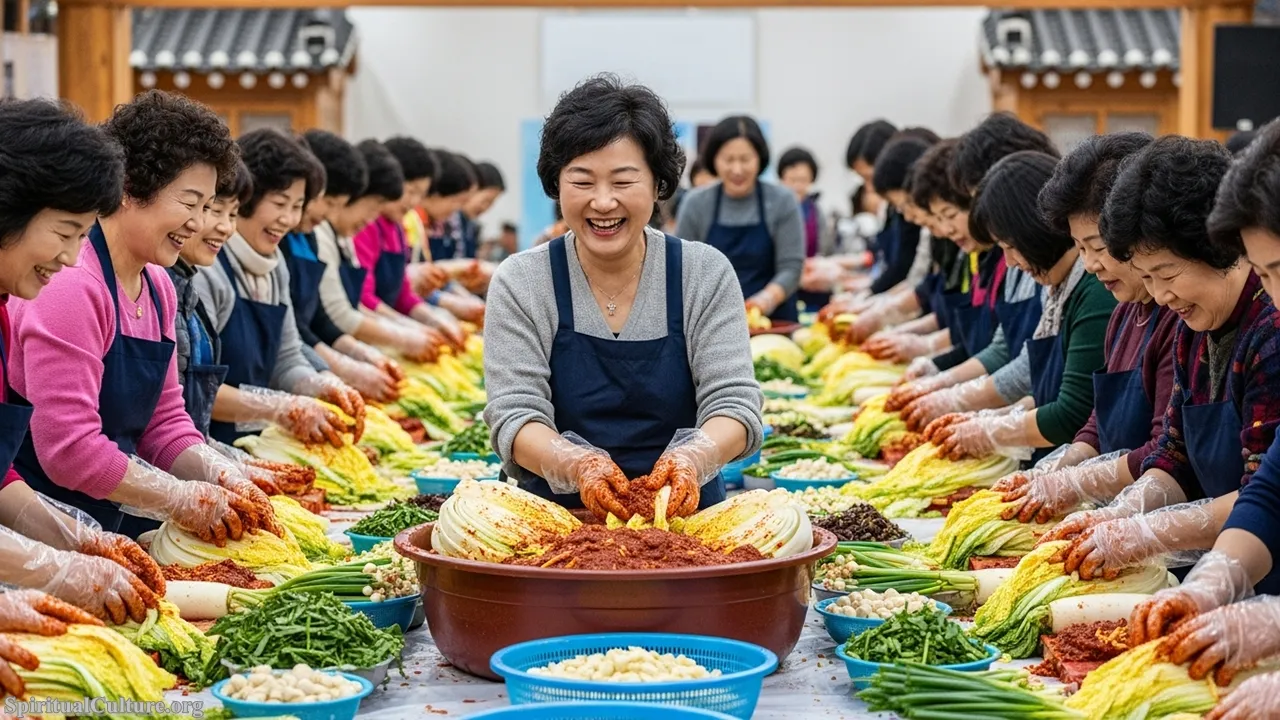
The spiritual impact of Kimjang is inextricably linked to communal solidarity and collective identity. It is a tradition where neighbors and family members gather, sharing labor and expertise, reinforcing the idea that survival and success are collective efforts. The exchange of kimchi after the process is a non-verbal affirmation of loyalty and care within the community. The spiritual value lies in the purity of the ingredients and the collective, mindful energy dedicated to the preservation process, a belief that good, pure energy makes the kimchi ferment properly.
Kimjang offers the enduring moral lesson that a strong society is built on the willingness of people to share labor, resources, and knowledge for the benefit of the whole. Its continuation, even in urban settings, is a vital preservation of the ‘we’ over the ‘I.’ For Spiritual Culture, Kimjang is a powerful, palpable metaphor for the spirit of interdependence that defines Korea’s cultural heart, manifesting spiritual principles in a delicious, practical form.
Cultural/Spiritual Highlights
- UNESCO Inscription: Recognized in 2013 for embodying the spirit of sharing and collective identity.
- Dure (Collective Labor): The act reinforces communal bonds and interdependence, essential to Korean social structure.
- Seasonal Knowledge: The tradition is a repository of ecological knowledge about weather patterns and optimal preservation techniques.
#2. Hangeul (The Korean Alphabet)
Hangeul, the Korean alphabet, is arguably the world’s most scientifically designed and linguistically efficient writing system. Invented and promulgated by King Sejong the Great in the 15th century, its stated purpose was profoundly humanistic: to ensure that “the common people, not knowing the Chinese characters, are unable to express their feelings.” Its creation was an act of supreme spiritual and intellectual liberation, giving voice and literacy to the entire population. Hangeul’s design principles are rooted in Confucian cosmology and phonological science, making it a masterwork of human endeavor.
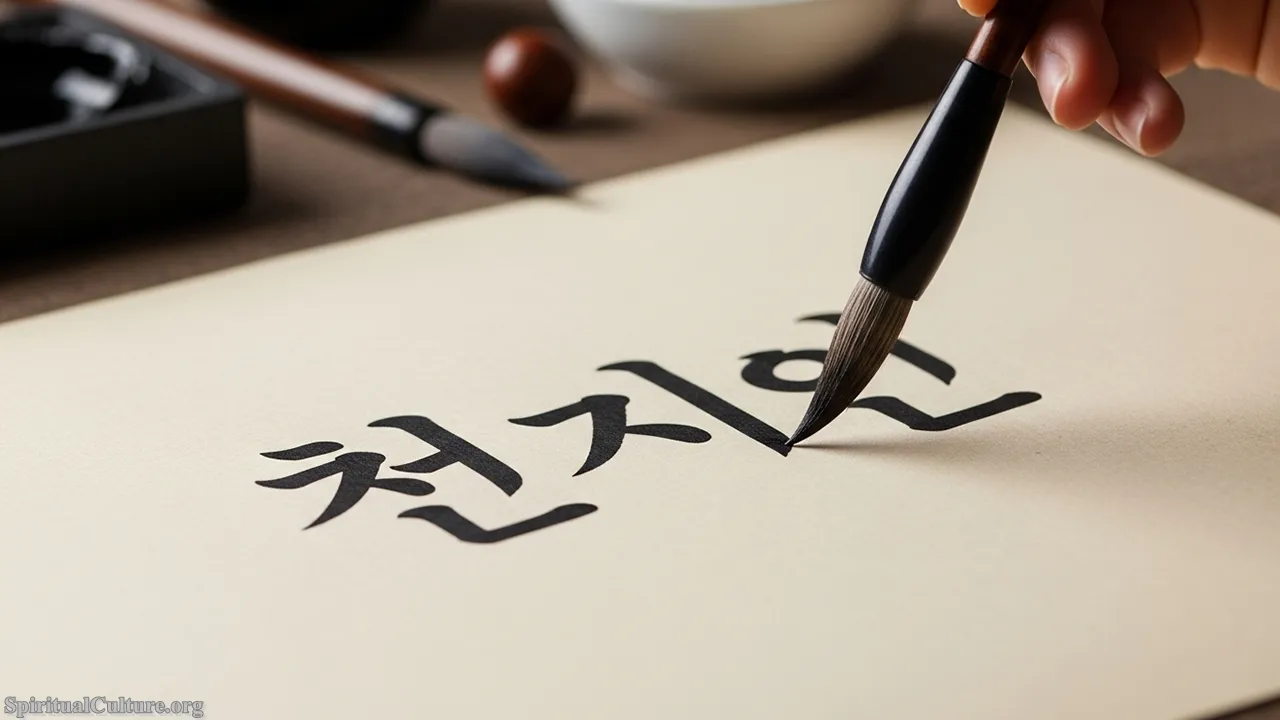
The spiritual impact of Hangeul is one of radical humanism and democratic access to knowledge. King Sejong’s initiative was driven by the spiritual ideal that literacy—and thus self-expression—is a universal human right. The shapes of the characters (e.g., vowels representing Heaven, Earth, and Man) embody the philosophical principle of Cheon-Ji-In (Heaven, Earth, and Humanity), spiritually linking the written language to the cosmic order. Its ease of learning led to rapid mass literacy, fostering a strong, unified sense of national cultural identity built on shared knowledge.
Hangeul’s global prominence and its inscription on the UNESCO Memory of the World Register (1997) offer the powerful moral lesson that the greatest instruments of culture are those that empower the marginalized. Its design, based on scientific principles (the shapes mimic the mouth/throat), is a celebration of both intellectual rigor and spiritual compassion. For Spiritual Culture, Hangeul represents the profound truth that giving someone the tools to speak their truth is the highest form of cultural and spiritual influence.
Cultural/Spiritual Highlights
- UNESCO Inscription: Memory of the World Register (1997) for its exceptional value and scientific design.
- Cheon-Ji-In: The vowels are designed around the cosmological principle of Heaven (dot), Earth (horizontal line), and Humanity (vertical line).
- Democratic Purpose: Created specifically to uplift the common people, enabling universal literacy.
#1. Jesa & Ancestral Rites (The Foundation of Family and Society)
Jesa, the collective term for the elaborate ancestral rites and memorial services, stands as the most influential and foundational tradition in Korean culture. This practice, performed on death anniversaries and major holidays like Seollal and Chuseok, is where the spiritual and cultural heart of Korea resides. It involves meticulously preparing ceremonial food, setting an offering table (Jesasang), and performing deep, formal bows to honor deceased family members. This rite is a constant, tangible performance of Filial Piety (Hyodo), the central virtue of Confucian society.
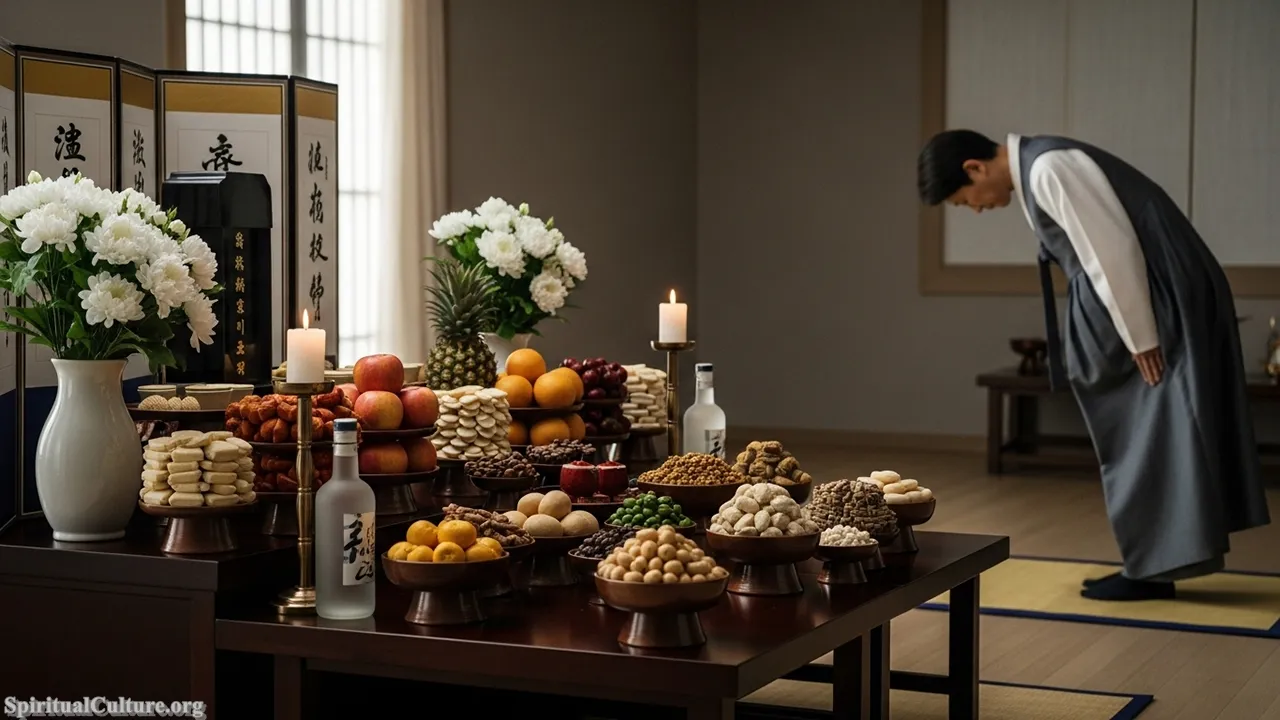
The spiritual impact of Jesa is the continuous presence of the departed. Korean tradition holds that ancestral spirits remain part of the family for several generations, and Jesa is the ritual that keeps the spiritual and physical family connected. The rites are not about worshiping a distant deity, but about fulfilling one’s duty and gratitude to the spiritual source of one’s own life, ensuring the family’s harmony and receiving blessings in return. The formality of the offering table, with foods strategically placed according to symbolic direction (e.g., fruit to the east, meat to the west), embodies the spiritual ideal of perfect cosmic order within the home.
Jesa offers the ultimate moral lesson that identity is intergenerational and collective. In a rapidly modernizing world, the commitment to traveling, gathering, and performing these rites—even if simplified—is an unshakeable national affirmation of the spiritual value of family lineage over individual pursuit. For Spiritual Culture, this tradition holds the number one spot because it is the unbroken cultural DNA that dictates social structure, respect for elders, and a profound sense of rootedness, making it the most fundamental and continuously practiced spiritual tradition.
Cultural/Spiritual Highlights
- Hyodo (Filial Piety): The ultimate cultural virtue; Jesa is the main mechanism for its performance.
- Spiritual Continuity: The act of eating the food offerings (eumbok) symbolically consumes the blessings of the ancestors.
- Symbolic Order: The Jesahyang (offering table) arrangement follows strict rules based on cosmic and social hierarchy.
Conclusion
The global phenomenon of K-Culture today is not a cultural vacuum; it is the highly visible peak of a profound and resilient spiritual mountain. As demonstrated by this Spiritual Culture ranking, the most influential traditions of Korea are those that reinforce collective values: the familial devotion of Jesa, the democratic humanism of Hangeul, and the communal solidarity of Kimjang. These are the ancient, unchanging pillars that have allowed Korea to navigate turbulent history and emerge with an identity that is both fiercely traditional and aggressively modern.
The continued, widespread practice of these traditions—many of which are now enshrined by UNESCO as universal human heritage as of the Current Time of Writing—sends a clear, celebratory message to the world: the enduring power of culture lies in the spiritual depth of its collective practices. By studying and honoring the ancestral virtues of Korea, the global community gains a powerful model for strengthening its own foundations of respect, community, and humanistic value.
We celebrate Korea’s ability to keep its spiritual heart beating while leading the cultural charge into the 21st century, proving that heritage is a living, breathing, and fundamentally influential force.
